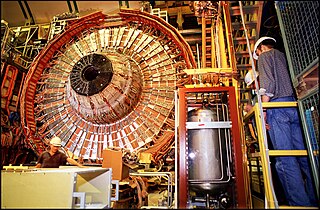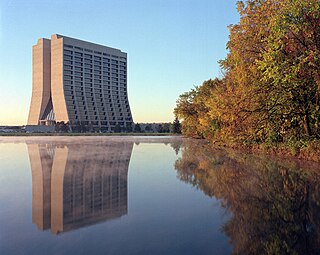
ATLAS is the largest general-purpose particle detector experiment at the Large Hadron Collider (LHC), a particle accelerator at CERN in Switzerland. The experiment is designed to take advantage of the unprecedented energy available at the LHC and observe phenomena that involve highly massive particles which were not observable using earlier lower-energy accelerators. ATLAS was one of the two LHC experiments involved in the discovery of the Higgs boson in July 2012. It was also designed to search for evidence of theories of particle physics beyond the Standard Model.

H1 was a particle detector operated at the HERA collider at the German national laboratory DESY in Hamburg. The first studies for the H1 experiment were proposed in 1981. The H1 detector began operating together with HERA in 1992 and took data until 2007. It consisted of several different detector components, measured about 12 m × 15 m × 10 m and weighed 2800 tons. It was one of four detectors along the HERA accelerator.

Gargamelle was a heavy liquid bubble chamber detector in operation at CERN between 1970 and 1979. It was designed to detect neutrinos and antineutrinos, which were produced with a beam from the Proton Synchrotron (PS) between 1970 and 1976, before the detector was moved to the Super Proton Synchrotron (SPS). In 1979 an irreparable crack was discovered in the bubble chamber, and the detector was decommissioned. It is currently part of the "Microcosm" exhibition at CERN, open to the public.

Jack Steinberger was a German-born American physicist noted for his work with neutrinos, the subatomic particles considered to be elementary constituents of matter. He was a recipient of the 1988 Nobel Prize in Physics, along with Leon M. Lederman and Melvin Schwartz, for the discovery of the muon neutrino. Through his career as an experimental particle physicist, he held positions at the University of California, Berkeley, Columbia University (1950–68), and the CERN (1968–86). He was also a recipient of the United States National Medal of Science in 1988, and the Matteucci Medal from the Italian Academy of Sciences in 1990.

The Underground Area 2 (UA2) experiment was a high-energy physics experiment at the Proton-Antiproton Collider — a modification of the Super Proton Synchrotron (SPS) — at CERN. The experiment ran from 1981 until 1990, and its main objective was to discover the W and Z bosons. UA2, together with the UA1 experiment, succeeded in discovering these particles in 1983, leading to the 1984 Nobel Prize in Physics being awarded to Carlo Rubbia and Simon van der Meer. The UA2 experiment also observed the first evidence for jet production in hadron collisions in 1981, and was involved in the searches of the top quark and of supersymmetric particles. Pierre Darriulat was the spokesperson of UA2 from 1981 to 1986, followed by Luigi Di Lella from 1986 to 1990.

DELPHI was one of the four main detectors of the Large Electron–Positron Collider (LEP) at CERN, one of the largest particle accelerators ever made. Like the other three detectors, it recorded and analyzed the result of the collision between LEP's colliding particle beams. The specific focus of DELPHI was on particle identification, three-dimensional information, high granularity (detail), and precise vertex determination.

The Collider Detector at Fermilab (CDF) experimental collaboration studies high energy particle collisions from the Tevatron, the world's former highest-energy particle accelerator. The goal is to discover the identity and properties of the particles that make up the universe and to understand the forces and interactions between those particles.

ALICE is one of nine detector experiments at the Large Hadron Collider at CERN. The experiment is designed to study the conditions that are thought to have existed immediately after the Big Bang by measuring the properties of quark-gluon plasma.

The DØ experiment was a worldwide collaboration of scientists conducting research on the fundamental nature of matter. DØ was one of two major experiments located at the Tevatron Collider at Fermilab in Batavia, Illinois. The Tevatron was the world's highest-energy accelerator from 1983 until 2009, when its energy was surpassed by the Large Hadron Collider. The DØ experiment stopped taking data in 2011, when the Tevatron shut down, but data analysis is still ongoing. The DØ detector is preserved in Fermilab's DØ Assembly Building as part of a historical exhibit for public tours.

ZEUS was a particle detector at the HERA particle accelerator at the German national laboratory DESY in Hamburg. It began taking data in 1992 and was operated until HERA was decommissioned in June 2007. The scientific collaboration behind ZEUS consisted of about 400 physicists and technicians from 56 institutes in 17 countries.

The LHCf is a special-purpose Large Hadron Collider experiment for astroparticle physics, and one of nine detectors in the LHC accelerator at CERN. LHCf is designed to study the particles generated in the forward region of collisions, those almost directly in line with the colliding proton beams.

CDHS was a neutrino experiment at CERN taking data from 1976 until 1984. The experiment was officially referred to as WA1. CDHS was a collaboration of groups from CERN, Dortmund, Heidelberg, Saclay and later Warsaw. The collaboration was led by Jack Steinberger. The experiment was designed to study deep inelastic neutrino interactions in iron.

The NA58 experiment, or COMPASS is a 60-metre-long fixed-target experiment at the M2 beam line of the SPS at CERN. The experimental hall is located at the CERN North Area, close to the French village of Prévessin-Moëns. The experiment is a two-staged spectrometer with numerous tracking detectors, particle identification and calorimetry. The physics results are extracted by recording and analysing the final states of the scattering processes.

Quark–gluon plasma is an interacting localized assembly of quarks and gluons at thermal and chemical (abundance) equilibrium. The word plasma signals that free color charges are allowed. In a 1987 summary, Léon Van Hove pointed out the equivalence of the three terms: quark gluon plasma, quark matter and a new state of matter. Since the temperature is above the Hagedorn temperature—and thus above the scale of light u,d-quark mass—the pressure exhibits the relativistic Stefan-Boltzmann format governed by temperature to the fourth power and many practically massless quark and gluon constituents. It can be said that QGP emerges to be the new phase of strongly interacting matter which manifests its physical properties in terms of nearly free dynamics of practically massless gluons and quarks. Both quarks and gluons must be present in conditions near chemical (yield) equilibrium with their colour charge open for a new state of matter to be referred to as QGP.

NA61/SHINE is a particle physics experiment at the Super Proton Synchrotron (SPS) at the European Organization for Nuclear Research (CERN). The experiment studies the hadronic final states produced in interactions of various beam particles with a variety of fixed nuclear targets at the SPS energies.

The NA62 experiment is a fixed-target particle physics experiment in the North Area of the SPS accelerator at CERN. The experiment was approved in February 2007. Data taking began in 2015, and the experiment is expected to become the first in the world to probe the decays of the charged kaon with probabilities down to 10−12. The experiment's spokesperson is Giuseppe Ruggiero. The collaboration involves 308 participants from 33 institutions and 16 countries around the world.

The NA49 experiment was a particle physics experiment that investigated the properties of quark–gluon plasma. The experiment's synonym was Ions/TPC-Hadrons. It took place in the North Area of the Super Proton Synchrotron (SPS) at CERN from 1991-2002.

Peter Jenni, is an experimental particle physicist working at CERN. He is best known as one of the "founding fathers" of the ATLAS experiment at the CERN Large Hadron Collider together with a few other colleagues. He acted as spokesperson of the ATLAS Collaboration until 2009. ATLAS is a world-wide collaboration which started in 1992 involving roughly 3,000 physicists at 183 institutions in 38 countries. Jenni was directly involved in the experimental work leading to the discoveries of the W and Z bosons in the 1980s and the Higgs boson in 2012. He is (co-)author of about 1000 publications in scientific journals.

Bradley Cox is an American physicist, academic and researcher. He is a Professor of Physics and the founder of the High Energy Physics Group at the University of Virginia.

The Underground Area 6 (UA6), also referred to as PHOTONS, experiment was a high-energy physics experiment at the Proton-Antiproton Collider, a modification of the Super Proton Synchrotron (SPS), at CERN. The experiment ran from 1984 to 1990, with the purpose of studying inclusive electromagnetic final states and lambda production in proton-antiproton and proton-proton interactions. Towards the end of its run it focused more on direct-photon and J/ψ production. The experiment is complementary to the UA1, UA2 and CDF experiments.















